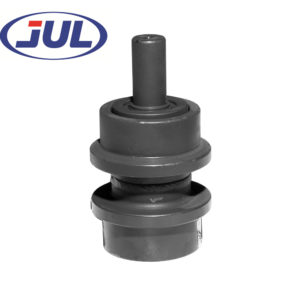Undercarriage rollers play a critical role in distributing the weight and load of heavy machinery, such as construction equipment and tracked vehicles.
Their primary functions in weight distribution are as follows:
- Support and Stability: Undercarriage rollers are strategically positioned along the length of the undercarriage of heavy machinery. They provide support to the tracks and, by extension, the entire vehicle. This support is essential for maintaining the stability and balance of the machine, especially on uneven or soft terrain.
- Weight Dispersal: The weight of heavy machinery is substantial, and it needs to be evenly distributed to prevent excessive ground pressure. The undercarriage rollers help disperse this weight across a larger contact area by supporting the weight of the machine on the tracks. This reduces the likelihood of the equipment sinking into soft ground or causing damage to paved surfaces.
- Reducing Ground Pressure: Heavy machinery often operates in sensitive or environmentally protected areas. Even weight distribution achieved through undercarriage rollers helps minimize the ground pressure exerted by the equipment, reducing soil compaction and environmental impact.
- Balancing Loads: Undercarriage rollers contribute to maintaining a balanced load distribution on the tracks. When the machine carries a load or operates on slopes, the rollers play a crucial role in evenly distributing the weight to prevent tipping or loss of stability.
- Track Tension Control: Some undercarriage rollers are designed to assist in maintaining proper track tension. The tension of the tracks affects the machine’s weight distribution and overall performance. Undercarriage rollers help in adjusting and maintaining the correct track tension to ensure optimal operation.
- Wear Reduction: By supporting the tracks, undercarriage rollers also help reduce wear and tear on the tracks themselves. This extends the life of the tracks and minimizes the need for frequent replacements.
In summary, undercarriage rollers are a fundamental component of heavy machinery undercarriages, and their role in distributing the weight and load is vital for maintaining stability, protecting the terrain, and ensuring safe and efficient operation. Proper maintenance and inspection of these rollers are crucial to ensure their continued effectiveness in weight distribution.
How do you inspect undercarriage rollers for wear and damage, and what are the signs of potential issues?
Inspecting undercarriage rollers for wear and damage is essential to ensure the proper functioning and longevity of heavy machinery.
Here are the steps for inspection and common signs of potential issues:
Inspection Steps:
- Visual Inspection:
- Start by visually examining each undercarriage roller, including the outer surface and components. Look for any visible signs of wear, damage, or irregularities.
- Check for Loose Components:
- Ensure that all bolts, nuts, and fasteners securing the undercarriage rollers are tight and not missing. Loose components can lead to problems.
- Look for Cracks and Breaks:
- Inspect the rollers for any cracks or breaks in the metal or rubber components. Cracks can weaken the roller’s structural integrity.
- Examine Rubber Pads:
- If the undercarriage rollers have rubber pads, check for excessive wear, tears, or missing sections. Worn-out rubber pads can reduce traction.
- Check for Flat Spots:
- Assess the roller’s surface for flat spots or uneven wear. Flat spots can lead to an uneven ride and increased vibration.
- Inspect Bearings and Bushings:
- Check the bearings and bushings for signs of wear, corrosion, or play. Excessive play or damage can affect roller performance.
- Listen for Unusual Noises:
- While operating the machinery, listen for any unusual noises coming from the undercarriage rollers. Unusual sounds can be an indicator of problems.
Common Signs of Potential Issues:
- Excessive Wear: Undercarriage rollers with significant wear may have a smoother or uneven surface. The loss of material can reduce their effectiveness.
- Cracks or Breaks: Visible cracks, breaks, or deformities in the rollers are clear signs of damage that require immediate attention.
- Loose Fasteners: If you notice loose bolts or fasteners, it’s essential to tighten them to prevent further issues.
- Uneven Wear: Flat spots or uneven wear patterns on the roller’s surface can affect the machine’s stability and ride quality.
- Abnormal Noises: Unusual or loud noises, such as squeaking or grinding, while the machine is in operation may indicate problems with the undercarriage rollers.
- Reduced Traction: If the rubber pads on the undercarriage rollers are worn out or damaged, it can result in reduced traction and decreased overall performance.
- Misalignment: A machine with track misalignment issues, such as tracks not running straight, can be a sign of problems with the undercarriage rollers.
- Increased Vibration: Excessive vibration during operation may indicate problems with the rollers’ condition or alignment.
If you identify any of these signs or issues during your inspection, it’s crucial to address them promptly. Regular maintenance, including the replacement of damaged or worn undercarriage rollers, is essential to ensure the safety and efficiency of heavy machinery.
